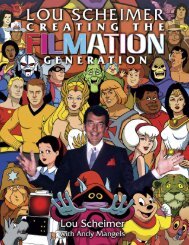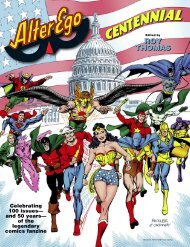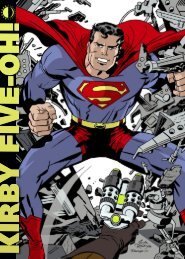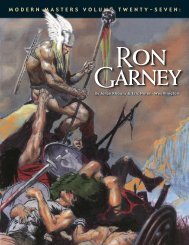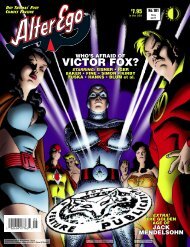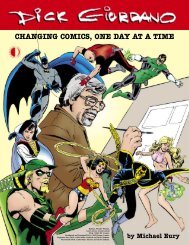JENETTE KAHN - TwoMorrows Publishing Store
JENETTE KAHN - TwoMorrows Publishing Store
JENETTE KAHN - TwoMorrows Publishing Store
Create successful ePaper yourself
Turn your PDF publications into a flip-book with our unique Google optimized e-Paper software.
glad I hired her because it started us on that track.<br />
GREENBERGER: Absolutely. Now, yes, you did the Super Friends comic<br />
and Shazam! and all, but you also did Welcome Back, Kotter, which felt<br />
like out of left field since it wasn’t based on any comic stuff. Was that<br />
an attempt to try the old licensing gambit that used to work so well?<br />
<strong>KAHN</strong>: Again, I don’t remember why we did that.<br />
GREENBERGER: Fair enough. Meantime, there was the success of the<br />
Wonder Woman live-action show with the wonderful Lynda Carter.<br />
You know, apparently it was Marty Pasko who suggested taking the<br />
book he was writing and turning it into a World War II book to<br />
mirror the TV show. Were you at all involved in the TV show or the<br />
comics adaptation?<br />
<strong>KAHN</strong>: No, I wasn’t involved at all with the TV show because that<br />
had been sold by another Warner Communications executive, Ed Blier,<br />
quite independent of us.<br />
GREENBERGER: But apparently, you did have input in the comics<br />
because of the success of the TV show, you took a look at the comic<br />
which at the time was being written by Marty and drawn by Jose<br />
Delbo and said, “Jose isn’t a strong enough artist for this important a<br />
property,” and you insisted he be replaced. Do you remember doing<br />
those sorts of creative decisions?<br />
<strong>KAHN</strong>: I don’t remember that particular one, but I often had creative<br />
input into the comics in terms of talent and ideas. And ideas would<br />
be pitched to me. I remember Len and Marv coming in, pitching<br />
Teen Titans, and at first, I was thinking, “Teen Titans? What a lame<br />
comic. Who cares about these teenage imitations?” But Len and<br />
Marv had a terrific pitch that reflected the new sensibility we were<br />
fostering and, I’m totally delighted to say, they convinced me.<br />
[chuckles] But the specific decision to remove a Wonder Woman artist,<br />
that I don’t remember.<br />
TRYING OUT NEW FORMATS<br />
GREENBERGER: The other thing is the comics at the time were cutting<br />
back on page count because of the economics. DC was down to, like,<br />
17 pages of story around the time you arrived and one of the things<br />
you were definitely playing with in those first four or five years was<br />
format. There were the original stories in the tabloids, better choices<br />
of the reprint material, you took the Legion and you took the Justice<br />
League and you bumped them up to 48 pages with twice the story<br />
page count. Do you remember playing with all of this stuff and then<br />
working with the editors to figure out what was going to work?<br />
<strong>KAHN</strong>: What I remember was just trying to give more—give more<br />
value to the readers and find a way to justify raising the price. Not to<br />
raise the price without giving value, but to find a way to add value and<br />
then raise the price so that the economics of comics would be better.<br />
GREENBERGER: And then, of course, there were the Dollar Comics,<br />
which really felt like you were getting your money’s worth.<br />
<strong>KAHN</strong>: The ill-fated Dollar Comics. I think ultimately, you didn’t get your<br />
money’s worth, even though, based strictly on the page counts, you did.<br />
But because—I remember it only had one lead story of new material and<br />
the rest was reprint. Is that correct, Bobby? You know better than I.<br />
GREENBERGER: Well, no. No, those were the 50-cent, 100-page Super<br />
Spectaculars that were there at the very beginning. But when you gave<br />
us in ’77, ’78, the Dollar Comics. They were 80 pages of new material.<br />
<strong>KAHN</strong>: Eighty pages of new material. I guess, then, it was in the quality.<br />
Perhaps because we were trying to do so much material at once, it<br />
wasn’t as strong as it might have been. Neal Adams did the covers…<br />
GREENBERGER: He did a lot of the first covers, yeah.<br />
<strong>KAHN</strong>: But then you had him on the cover, but you didn’t have him<br />
on the inside. I think Dollar Comics were a good concept but they<br />
weren’t executed as well as they might have been and they might<br />
have been a little early.<br />
[Editor’s note: For more on Dollar Comics, see the article beginning<br />
on page 39.]<br />
GREENBERGER: Speaking of the new material in the tabloids,<br />
how involved were you in making the Superman/Muhammad Ali<br />
book a reality?<br />
<strong>KAHN</strong>: Strangely, even though Don King, who was a big boxing<br />
promoter and still had a strong relationship with Muhammad Ali,<br />
even though he came first to Sol’s office and that was the kind of<br />
thing that Sol usually was excited about, he handed it off to me.<br />
I was tremendously involved in the comic and it was an exciting<br />
experience because I got to work with Ali’s team and with Ali himself,<br />
and I wrote about it in the introduction to the recent reissue of<br />
Superman/Muhammad Ali.<br />
And, of course, I was also responsible for one of the colossal<br />
challenges/catastrophes [chuckles] of the Superman/Muhammad Ali<br />
book. I had what I thought was an inspired idea. I said, “We have a<br />
huge double cover with no ad in the back and with Supes and Ali<br />
in the ring together. And who comes to boxing matches? All the<br />
glitterati. So let’s fill the entire audience with famous people,” and we<br />
proceeded to do just that. And Neal drew all these famous people in<br />
the stands. It was only after they were drawn that we learned that if<br />
we were using their likenesses, their images were aiding in the sale<br />
of the comic book, and we needed their permission to use them.<br />
Needless to say, we didn’t have it.<br />
I had to travel the country to try to convince the people who were<br />
already on the cover to allow us to use their likenesses. And when<br />
they wouldn’t give us permission, we had to draw somebody else<br />
with a similar physiognomy in their place. So George C. Scott,<br />
for instance, became Kurt Vonnegut. If I looked at the cover, I could<br />
More for Your Money<br />
JLA and Legion got page count boosts in a Kahn<br />
decision. Cover to Superboy and the Legion of<br />
Super-Heroes #231 (Sept. 1977) by Mike Grell.<br />
TM & © DC Comics.<br />
1 4 • B A C K I S S U E • J e n e t t e K a h n I s s u e



